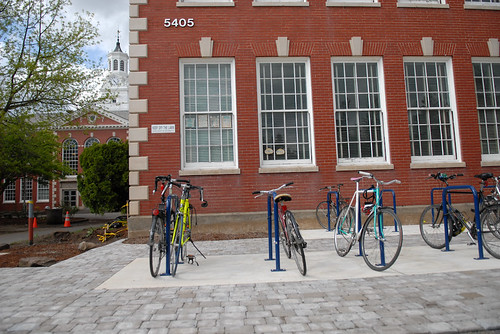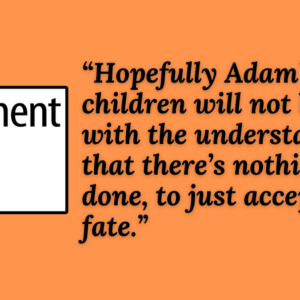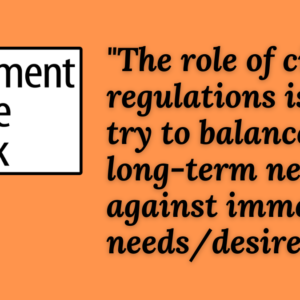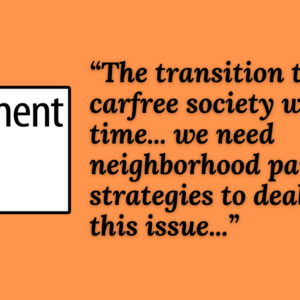
Just ask Franklin High School.
(Photo: J.Maus/BikePortland)
Good bike parking: it’s not that hard but it’s not that common, at least in North America. Except in Portland, where we really do know how it’s done.
The explanations don’t get any shorter and sweeter than this one from BikePortland reader Jessica Roberts, who shared it beneath our story Tuesday about the city enforcing its bike parking code on a North Portland Home Depot in response to a resident’s complaint. (As we wrote, anybody can report potentially out-of-compliance bike parking in Portland by calling (503) 823-CODE (2633) or using the BDS online form.)
Here’s Roberts’ simple definition, plus a couple examples of rack designs that don’t cut it:
A good bike rack provides two points of contact to hold up the bike, allows you to lock the frame and the wheel with a U-lock, works for all types of bikes, and organizes bicycles so they do not block the pedestrian space. Toast racks don’t allow for the frame to be locked, and don’t have 2 points of contact. Ribbon racks don’t have 2 points of contact and often end up blocking pedestrian space.
So clear. So true. So rare.
Advertisement
Honorable mention here goes to reader JJJJ, who observed beneath the same post that Portland deserves credit for continuing to lead the nation in good bike parking. That’s totally true, and it’s something we can all be proud of.
Yes, we pay for good comments. We’ll be mailing a $5 bill to Jessica in thanks for this great one.





Thanks for reading.
BikePortland has served this community with independent community journalism since 2005. We rely on subscriptions from readers like you to survive. Your financial support is vital in keeping this valuable resource alive and well.
Please subscribe today to strengthen and expand our work.
As a Franklin student, I am duty-bound to make complaint at the lack of covered bike parking, and lack of sufficient parking for fair-weather demand.
https://drive.google.com/file/d/0B6fZdYTKFc14MU5sTW1WbUMyOFR2dGdlTUxSRXg5RExxcHRN/view?usp=sharing
Certainly glad that it is installed correctly though!
This brings up a good point that wasn’t discussed much in the original thread. I’m way more concerned with the lack of coverage of bike parking than the actual racks themselves. We really don’t have nearly enough covered parking in this city.
Schools are the perfect place for rental bike lockers.
Will those issues be addressed when the school is renovated this summer?
Hopefully.
This makes me pretty optimistic:
https://drive.google.com/file/d/0B6fZdYTKFc14TlVULUM5MnF4WVE/view?usp=sharing
(zoom in a lot)
Don’t think any actual plans have been published yet.
I’ve never understood why this is such a big deal. I suppose it’s a nice amenity, to be able to open my waterproof bags without getting so much as a raindrop in the top, but other than that I don’t get it. If you’ve just completed a commute in the rain, I’d assume you’re dressed for it, and your bike isn’t getting any wetter by leaving it out while you go about your business.
Of course, every bike should come inside at night and have a chance to dry off, which will minimize the effects of exposure.
One local elementary school here spent $64,000 for covered parking, touting it as a way to boost rider numbers. I’d bet they could have gotten a much better return on investment by putting that money toward contracting with an advocate to develop programs to encourage more ridership.
Just suppose that every car was required to be roofless by law, like bikes and motorcycles are by design. Do you not suppose that people would clamor for covered car parks to avoid sitting in a puddle after it rains, or sitting on a seat that was hot enough to cause 1st degree burns after the car sat in the sun in 110F heat (just to get TX back in the equation)? Same deal for bikes, even the best seat design will still give you a wet butt if left out in the rain before riding.
It’s a bit disingenuous to argue that bikes are OK (and designed to be) ridden without overhead protection from the elements but that once they are stationary such coverage needs to be provided.
I don’t think that’s disingenuous. It’s just acknowledging that they’re not made or OK to be stored outside in the rain.
For shopping, where you may not be parked much longer than you were riding, leaving it uncovered is one thing. For school or work, or at transit stations with lots of park-and-ride activity, places the bike is going to be left all day, cover is a big deal.
The small number of staples, of course, is directly related to the luxurious spacing between them. Should places with lots of bike parking needs install some racks that can fit cargo bikes comfortably? Sure! Should most of the racks be much smaller and closer together? Absolutely! If we’re planning for a mass cycling future we should look at some places that have mass cycling, or have had mass cycling. It would’t surprise me if this high school actually had much higher student cycling rates a couple generations ago (it’s true most places), with lower-quality but much denser parking. Some cities and university buildings use closely-spaced mini-staples — Everitt Lab at the University of Illinois is an example that’s considerably denser than what’s pictured. Some busy train stations and workplace garages in the US have some vertical, hanging parking — not every rider can use it, but it’s pretty efficient for the majority that can. At the high end of density, many train stations around the world, especially in places like Japan and the Netherlands, use various tricks to achieve multi-level parking. That’s good bike parking because it can plausibly meet the capacity needs of its users.
Except if I’m at work for 8-10 hours, it’s nice to have my bike dry out, and not have a soaking wet seat when I get ready to ride home. 30 minutes in the weather is always going to be less detrimental to a bike than 10 hours in the weather.
…or snow and ice build up during the winter.
[Nothing makes my g-friend grumpier than having ice on her saddle while riding with a skirt…there are always a few bits that do not break off…then its wet underwear and grumpy. Imagine if car drivers had to sit on their half scraped windscreens as they drove home. Heated leather seats its not!]
“…Of course, every bike should come inside at night and have a chance to dry off, which will minimize the effects of exposure. …” Ron G.
If possible, being able to drip dry outside during the day when the bike is parked, is good too. I don’t think it’s good for mechanical things, including bikes, to be constantly wet.
This being Oregon where it likes to rain a lot (hopefully, because drought is worse.), things like rust and algae like to grow. May not see it right away with the naked eye, but that stuff happens on things left out in the open. It’s how cars left exposed to the elements can often rapidly acquire weathered paint.
People having to park their bikes out in the elements during for long hours while at work, school, etc, and that want to allow their bikes to drip dry, could get some sort of lightweight cover. Not uncommon to see motorcycle owners taking this approach.
I think three things make the ideal bike parking: the kind of rack (which has been discussed much), the location, and the quantity.
My biggest gripe about location is when it seems ideally located for bike thieves. This takes many flavors: around the corner, out of the way, not visible from anywhere inside (the shop/restaurant/business), where passersby can’t see it, etc., etc. Planners need to realize that bikes are valuable (either actually expensive or risk of lost transportation), and the parking location needs to take this into account. It doesn’t need to be front and center. But it most certainly shouldn’t be out back where you’d leave your old lawnmower. I could argue that since it does seem to rain here that covered parking would seem obvious, but that’s an optional luxury. Businesses who opt to do it might get more customers.
As far as quantity – just take a look around during peak times (and peak weather like Stevie mentioned) and see how full the racks get. Compare the number of parking spots to the number of bike racks. Its great to avoid bad traffic when biking. It sucks to arrive somewhere and have no where to lock your bike. On the bike theft threads, there are lots of mentions about how unsecure sign posts are – but I’ve locked my bike to sign posts many times because all other available rack space was taken.
often when riding with a friend we just lock our bikes together and not to anything anchored to the ground… but not for longer than an hour or so…
“Will it be there when I get back?”
8 words
Before we praise Franklin HS’s bike parking too highly there’s two numbers you need to know:
1,480 (number of students)
20 (number of bike staples)
This means that only 1 in every 37 Franklin students can park their bikes at a staple before having to resort to using handrails and street signs.
And how many of those racks are consistently full?
Another question: how many more students would bike if not for the insane car traffic near Franklin right before and after school?
Presumably some of that car traffic would be diminished, since those folks would now be biking, right?
How hard could it be to create incentives/disincentives? Or simply forbid driving? Does the Franklin staff get there by means other than the cars? If not I’d start there.
Yeah, the only parking on the Franklin campus is for staff. Though the % of staff biking might not be much less than that of students, I don’t think hardly any staff members take TriMet or walk, so most are in cars.
I don’t really know what to think about the traffic on Woodward, because it just doesn’t take that many cars stopped in the lane and swerving around to pick up kids to create the major traffic that is seen there every morning and afternoon.
My mind goes to something like banning private motor vehicles (other than direct Woodward residents’ and those needed for disabled students, etc.) on Woodward between 52nd and 58th (or 56th, say) during a window around the school start time and a window around the school end time. It would need considerable coordination between the school and the City, and some staff time probably from the school to move around some sort of barriers with signs. (And political will, and outreach to the students, staff, parents, and neighbors).
The advantages:
-School buses (are there any for high schoolers?) get in and out faster
-The student/parent cars would be spread out over a wider area (I’d imagine 52nd-58th between Powell and Tibbetts, 51st, and even 58th near Clinton would become more popular options) causing less intense traffic isues
-Related: a small but significant amount more exercise for students who drive to Franklin or are dropped off in private motor vehicles.
-Resulting from decreased traffic: more pleasant and safe experience for students when they walk, bike, or take TriMet to Franklin. Improved air quality near the school.
-Resulting from decreased traffic: Woodward bikeway, currently not a quick, safe, or pleasant experience for even non-student people biking around school start/end times, would become quicker, safer, and more pleasant.
Of course, a successful advocacy campaign would start with far-less “drastic” measures. It would start with building a core group of supporters (students, family, staff) and convincing the administration that this is a serious problem that calls for prioritized attention. It would then try a series of small steps:
-Encouragement campaign for students and staff to take non-car modes to Franklin (and provision of the tools to help them do that).
-Flyering and other encouragement for students driving to school to park further away and (especially) family dropping students off to drop off further away.
-More bike parking
-etc.
Once all “small” steps are taken, a “trial” closure could be undertaken, likely with the help of Better Block PDX. I bet that during the “trial” closure, most people would realize that things just work better that way. If any Franklin students or staff want to touch base and try to get some help from BikeLoudPDX, email me at bikeloudpdx@gmail.com .
Generally from about 20 (one bike per rack) on rainy days in the winter, to consistently all full at the beginning and towards the end of the school year when the weather is nice.
This is what it looked like on most days this past September.
https://drive.google.com/file/d/0B6fZdYTKFc14MU5sTW1WbUMyOFR2dGdlTUxSRXg5RExxcHRN/view?usp=sharing
That’s 40 bikes on the racks, plus at least 15 on adjacent railings, and I’d estimate at least 20 more parked on other available railings and such around the school, plus a few brought inside.
Since it gets that hard to find a place to park your bike, IMO there isn’t enough bike parking, though it is definitely unfortunate that it isn’t used more in the rainy months.
Yes, sounds like they need more parking if all the racks are full.
I also don’t care if it my bike is exposed to the weather. If you ride in Portland, you will be exposed to the weather regardless. The biggest issue is theft: Portland is a good place to ride, but a horrible place to park.
I like rain riding, just not the muck it leaves on my backside when I’m done. If only I could fit fenders on my salvaged beater bike (an older GT steel frame mountain bike with new skinny wheels). Local bike shop guru told me “it would take too much modification to fit fender between the rear brake calipers – not worth it for that old bike.”
Sad.
I don’t the current availability status of them, but one of the plastic SKS brand ( I think that’s it.) short length fenders that strap onto the seatpost, has been working great for me. The so called ‘high end’ Specialized mountain bike, abandoned and found, that bikeportland did a story about middle of last week, had one on it.
Of course, if you’ve got panniers, racks and whatnot, this type fender may not work for you. Innovate.
I’ve been mislead by bike shop employees lacking in knowledge (or perhaps some are being disingenuous?) regarding things like fenders. After being told by multiple bicycle shops that fenders could not be added to my GT Aggressor 3.0 mountain bike, I found some fenders that did work (after swapping the 2.1″ mtb tires with 1.6″ slick tires). They are made by Planet Bike and do not require eyelets. They are fastened to the fork and rear dropouts with rubber straps and zip ties. Hopefully they are what you’re looking for: Planet Bike SpeedEZ ATB Front and Rear Bicycle Fender Set (60mm Wide). http://amzn.to/1A3VkOo
Thank you Gerald, I will look into theoe fenders. Gotta do something short of getting a new bike!
those look like the ones available at almost every Portland bike shop…
Was this actually in Portland, or back where you came from before (I remember you saying you moved from Hawaii).
Can’t imagine a lot of mechanics in Portland trying to dissuade you from fenders. There are all kinds of models, so that you can fit some on pretty much any bike.
It was a salesman in a store that will remain nameless, in downtown-ish SW Portland, quite large and clean and well-lighted and apparently well-respected. My old bike (a Craigslist beater that I have lovingly restored) drew some admiring looks from the other wrenchers (they liked the old-skool steel frame and original paint job) but when I asked about fenders for it… well, I was strongly dissuaded and advised to wait until my “real” road bike arrives (still in Honolulu) before spending “lots of $” on fenders. Problem is my “real” bike won’t get here for months, and I gotta ride like, now, man…
I’ll just drop the $40 for the fenders and save myself the $50 or so labor fee by installing them myself. I’ll need to modify the rear one a bit to fit through the seat stays and clear the brake calipers; luckily the fenders are made of plastic and should be easy to cut with a sharp blade.
The ones linked to above (the quickly removable kind that stay on with rubber straps) work pretty well for tight-fitting road bikes. I have to a set on my temp commuter now. They’re not the absolute best, but definitely keep your backside dry, and are easy to remove/adjust.
I have no idea, but this picture suggests things could be better:
http://bikeportland.org/2015/02/06/comment-week-43-words-perfectly-define-good-bike-parking-134258#comment-6162782
Yes, looks like it.
Providing good parking for bikes, compared to parking for motor vehicles, poses quite a challenge. I’m aware of some of the various means devised to provide parking for bikes that’s efficient, can meet growing demand, and that doesn’t look too ugly. I haven’t seen much yet that’s the real deal.
The creation of barren plains of asphalt that can provide secure for parking cars is disturbing, but doing that is comparatively simpler than providing equivalent amount of secure parking for bikes. And may be less unattractive as well.
In some European locations, scenes, apparently common, of mass conglomerations of parked bikes all jammed together along streets and wherever, isn’t a very appealing approach either.
Car parking is not as simple as you suggest. We’ve designed so many parking lot aisles it’s become routine, but practices have evolved over time to improve safety and efficiency. And, of course, the implications of the space car parking takes up extend far beyond that land itself, and beyond subjective aesthetics.
Bike parking is not as hard as you suggest. This holds over 100 bikes. It’s a tiny area in front of the building, and similar areas abound all over America’s college campuses. Old college campuses, often built before bikes or cars were popular, remain some of America’s most graceful collections of buildings. They have accommodated a great number of bikes and changed much less doing so than they have changed to accommodate great numbers of cars.
Another interesting tidbit about the Franklin bike parking- officially, you’re not allowed to park a bike ANYPLACE ELSE.
Meaning, when they are full, what are you to do? I understand not wanting egress routes blocked by bikes on the railings, but technically, there is no permissible overflow area.
So, it’s basically nice, but that’s it- one for every 37 students.
Well, I would like to proudly say my son has been biking year round to Franklin his entire attendance (now a senior). Since he has two homes half the time that is 4 miles round trip and half the time it is 8 miles round trip.
Nice work, parents/guardians! I hope my son will do the same. Actually, he may have no choice. 🙂
I wonder how many of the bikes are “properly” secured. The white and
Oops, didn’t finish! White and turquoise bike has U-lock thru frame only, not front wheel. I “lost” a front wheel like that once. The local PD were kind enough to give me and my bike a ride home.
Now THIS is perfect bike parking
http://www.bikerumor.com/2015/02/19/video-japans-amazing-automatic-underground-bicycle-parking-garage/